How to compose and use biofertilizers safely and effectively

This post is also available in:
This post is also available in:
![]() Español (Spanish)
Español (Spanish) ![]() Français (French)
Français (French) ![]() Deutsch (German)
Deutsch (German) ![]() हिन्दी (Hindi)
हिन्दी (Hindi) ![]() العربية (Arabic)
العربية (Arabic) ![]() Türkçe (Turkish)
Türkçe (Turkish) ![]() 简体中文 (Chinese (Simplified))
简体中文 (Chinese (Simplified)) ![]() Ελληνικά (Greek)
Ελληνικά (Greek) ![]() Português (Portuguese (Brazil))
Português (Portuguese (Brazil))
The principles of Biofertilization
What is a biofertilizer?
The Biofertilizer is a liquid organic fertilizer that can be produced within any rural property, with materials that are easy to find on the property itself (animal manure and plant remains). Its preparation is very easy and occurs in a relatively short time, being ideal to complement the fertilization with Compost.
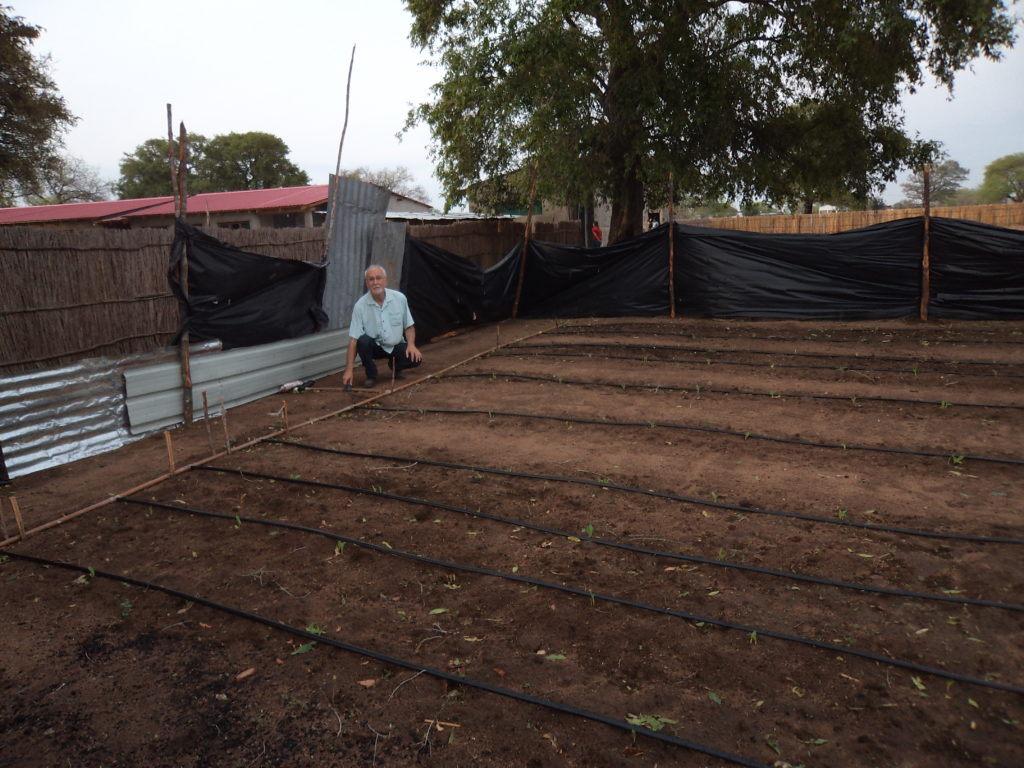
Produced and composed from living organisms, it is a natural fertilizer that contains the main minerals that feed plants directly, increasing nutrient uptake and root biomass while helping the plants control pests and diseases.
Biofertilizer is harmless to humans, animals, and the environment in general and is defined as: economically viable, ecologically correct, socially just, culturally suitable, technologically appropriate, and scientifically proven.
Thus, it becomes ideal for smallholder producers and/or family farmers, especially those who produce basic and fundamental foods for human consumption.
 The growing use of chemical fertilizers and pesticides, as a motivation for the alleged increase in agricultural production, has caused a harmful accumulation of pesticides in food and the contamination of water, soil, and the atmosphere, poisoning particularly the farmers themselves but also the people in general. In parallel, the perverse selection of resistant pests and the consequent need for higher doses or even more toxic new products stand out.
The growing use of chemical fertilizers and pesticides, as a motivation for the alleged increase in agricultural production, has caused a harmful accumulation of pesticides in food and the contamination of water, soil, and the atmosphere, poisoning particularly the farmers themselves but also the people in general. In parallel, the perverse selection of resistant pests and the consequent need for higher doses or even more toxic new products stand out.
The current growing demand for healthy and toxic-free foods and the need to use agricultural inputs that do not bring risks to human health, animals, and the environment in general, have increased and now consist a pressuring issue driving significant changes in the sector.
In this context, Biofertilizers and Biopesticides are rising once more as safe solutions for the production of healthy food and socio-environmental protection.
Biofertilizer Toxicity:
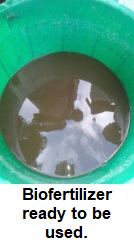 Biofertilizers, in principle, have very low toxicity for people, animals, and the environment. Even so, it is recommended not to come into contact with the mouth, nose, ear, and eyes, and as a precautional measure, to wash them out with clear water if they come in contact with the skin. It is recommended as a priority to keep children away when Biofertilizers are produced, handled, stored, and used. Adults who are handling Biofertilizers, even if there is no apparent contact, they should wash their hands, arms, and the entire face with clean water after handling the biofertilizers. If there is contact with any part of the body, this part should be washed with clean water.
Biofertilizers, in principle, have very low toxicity for people, animals, and the environment. Even so, it is recommended not to come into contact with the mouth, nose, ear, and eyes, and as a precautional measure, to wash them out with clear water if they come in contact with the skin. It is recommended as a priority to keep children away when Biofertilizers are produced, handled, stored, and used. Adults who are handling Biofertilizers, even if there is no apparent contact, they should wash their hands, arms, and the entire face with clean water after handling the biofertilizers. If there is contact with any part of the body, this part should be washed with clean water.
ATTENTION: These recommendations are only precautional. In principle, Biofertilizers have very low toxicity.
Biofertilizers can be used in any cultivation, but their use must be controlled to avoid overuse.
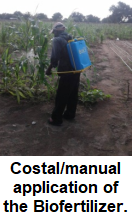 Despite their numerous advantages, the overuse of Biofertilizers can cause chemical, physical, and biological imbalances, making the soil unsuitable for the cultivation of certain species, in the same way as chemical fertilizers.
Despite their numerous advantages, the overuse of Biofertilizers can cause chemical, physical, and biological imbalances, making the soil unsuitable for the cultivation of certain species, in the same way as chemical fertilizers.
In any case, farmers should apply Biofertilizer after watering or rainfall and during the cooler hours of the day.
The frequency and time of application depend on the species. The best way to decide the time of the application of biofertilizers to the crop is by observing the development of plants. In general, these applications can be repeated weekly until the second month of cultivation growth. From the third month onwards, the farmer can apply them every 15 days.
Foliar applications are not recommended during plant flowering. Applications are recommended before flowering or after fertilization and can be applied to growing fruits. When sprayed directly on the leaves of vegetables or on fruits to be harvested soon (almost ripe), a minimum of 45 days should be allowed for human consumption of these raw products. Even then, it is recommended to wash vegetables and fruits with a 2% solution of vinegar in drinking water before consuming them. Minimally processed products with boiling, roasting, baking, or others are safer.
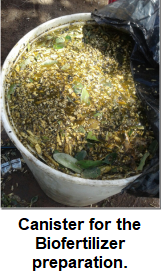 Suppose the Biofertilizer is obtained only from vegetable products, in other words, WITHOUT the use of animal manure*. In that case, the raw vegetable products can be consumed after a grace period of seven days and after they have been washed sufficiently with clean running water. However, as mentioned before, the ideal is to use a 2% vinegar solution to wash them before consumption.
Suppose the Biofertilizer is obtained only from vegetable products, in other words, WITHOUT the use of animal manure*. In that case, the raw vegetable products can be consumed after a grace period of seven days and after they have been washed sufficiently with clean running water. However, as mentioned before, the ideal is to use a 2% vinegar solution to wash them before consumption.
*Biofertilizer WITHOUT animal manure is a viable alternative for communities that reject Biofertilizer with animal manure but wish to practice Agroecology to eliminate the use of chemicals.
In case that Biofertilizers are produced only with animal manure, the grace periods for consumption are strict. So, in case of doubts or suspicion of the farmer: for vegetables for immediate consumption, we recommend only FERTIRRIGATION, that is, the application of any Biofertilizer directly to the soil, diluted (Dilute 1L of Biofertilizer in 05 to 10L of clean water) in clean water. In the form of Fertigation, the Biofertilizer applied directly to the soil also provides excellent plant growth. The consortium “SPRAYING + FERTIRRIGATION” is possible and highly recommended.
In pastures: A grace period of seven days is recommended before the resident animals return to graze at the application site.
Seeds: They can also be treated with pure Biofertilizer before planting, immersing themselves in pure syrup for 20 minutes. Before sowing, the treated seeds need to dry (in a ventilated shade place).
Finally, it is not recommended to apply the whole amount of Biofertilizers in a single application, as nutrient losses may occur through erosion and leaching.
It is recommended to apply it until the start of the harvest to cover the plant’s needs throughout the growth stages. Always remember that the dilution dose is what differentiates the “medicine” from the poison.
How to produce and apply biofertilizers?
Basic dilution of biofertilizers:
Fertigation: For direct use in the soil. Dilute 1 liter of Biofertilizer in 0.5 to 10 liters of clean water. Apply evenly the diluted mixture using a manual watering can until continuous surface wetting of the cultivated soil is noticed, without runoff.
Spraying: For foliar use. Dilute 1 liter of Biofertilizer in 10 to 20 liters of clean water. Apply the diluted mixture using an ordinary backpack sprayer bathing the plant without runoff.
Biofertilizers Production – Complete Recipe
(Aerobic Processing)
(Note: The anaerobic processing is more efficient but more complex and will be provided at another opportunity)
Basic ingredients:
- Canister (tank/can/cylinder/barrel) of 200L. Reserve a cool, protected, and easily accessible place, sheltered from the weather.
- 20 liters of fresh manure: Preferably bovine/goat/rabbit/horse (Therefore not tanned, and random mixing or mixing is allowed). Chicken and pig manure requires greater health care, so their use is avoided. Under no circumstances use dog and cat manure. Ensure the animals had not received antibiotics in the last week before the waste was produced.
- Clean water (200L minimum). Water quality is essential.
- 40L of unprocessed plant material (chopped and not pounded).
You can use plant materials that are easily available on site, i.e. not necessarily all listed below***.
In fact, we will be able to produce Biofertilizers with amounts of plant material that vary from 0 (zero) to 40L, and with the amount of animal manure always kept at 20L in the same 200L of water.
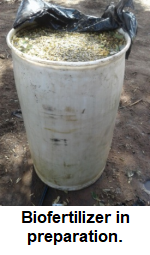
Recommended plant material or plant additive:
- Green leaves of native vegetation and/or green leaves of any species in the region (except eucalyptus);
- Resident weeds (whole);
- Vines (including the thin branches);
- Banana leaves;
- Bamboo leaves;
- Fallen fruits (green, ripe, stale) of any species native to the region (or non-native). Inflorescences are also included;
- Aviary bed, rabbit farming bed;
- Chopped sugar cane (including leaves);
- Chopped cassava plants (including leaves);
- Woodstove ashes (1Kg max and avoid leftover charcoal).
VERY IMPORTANT:
If on the farmer’s property there are plants resistant to crop diseases and can grow easily even in poor soils, then it is highly recommended to use their leaves in the mix and apply them as a vegetable additive.
Method of Preparation: Step by step
- Deposit all the fresh manure in the 200L canister;
- Deposit all the chopped plant material immediately afterward;
- Top up with clean water until the entire volume of the canister is filled;
- Turn over with a stick and cover or only cover the canister and let it ferment;
- Turn over the contents with a stick every day until fermentation is complete, which will take approximately 30 days;
- Filter the final product through a fine-mesh sieve or a cotton cloth;
- Bottle up internally washed pet bottles with a well-sealed lid and store them in a cool place, protected from bad weather.
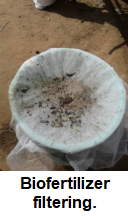
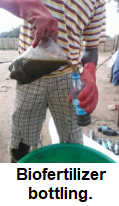
ATTENTION: The filtered and bottled Biofertilizer should no longer contact atmospheric air and can be stored for one year, until the exact moment of its use at the field when it will be diluted in clean water as previously explained.
NOTE: The solid part of the Biofertilizer (the material retained in the sieve or the fabric after filtering) is also an excellent source of organic matter and nutrients for plants and can be used directly in the cultivated soil.
Finally:
The continuous use of Biofertilizer and Biofertilization ALLIED WITH COMPOSTING will allow each community to adapt its production to its needs, finding the ideal components as well as their respective quantities.
Biopesticides:
If you want a Biofertilizer with a natural defensive function, just add in the tank whole plants (leaves, flowers, fruits, roots, bark, and thin stalks) that are recognized for their insecticides/bactericides/fungicides/nematicides/acaricides, etc properties. Such plants are: tithonia, marigold, etc, and even tobacco leaves.
- For gardens, flower pots, vegetable gardens, and home gardens, we recommend crushing 5 garlic cloves with 5 pepper cloves in a liter of water.
- Leave the solution to rest for 24 hours.
- Then filter the solution with a cotton cloth.
- Dilute the filtered solution in 5 liters of water and apply by spray on the plants attacked by the pests. If the pest attack is too intense, dilute the solution with less water. In extreme cases, it is possible to apply the pure solution obtained immediately after crushing the garlic and pepper, or to increase the amount of garlic and pepper to be crushed.
- Be careful that the sprayed product does not get into your eyes.
ATTENTION: You should not use tobacco leaves repeatedly because it causes chemical dependence. It should only be used occasionally.
We also inform you that pure Biofertilizer can be used as an aid in the fight against ants and chewing insects. Simply flood the anthills or insect nests with the pure product until they are completely soaked from the inside out.

The permanent dialogue between producers and the rural extension will make it possible to resolve all manufacturing and use doubts, as well as all related matters.
Other important allies of the farmer for sustainable food production are: Biological Control and Associative (Cooperativism), which will be addressed in future publications.
BIOFERTILIZATION (COMPLEMENT):
- Extension technical briefings on Bio fertilization in African vernacular languages (Swahili, Lingala, Kikongo, and Kiswahili) accompanied by versions in English and French named BT 114 at RI/UFLA http://repositorio.ufla.br/jspui/handle/1/48285








































































